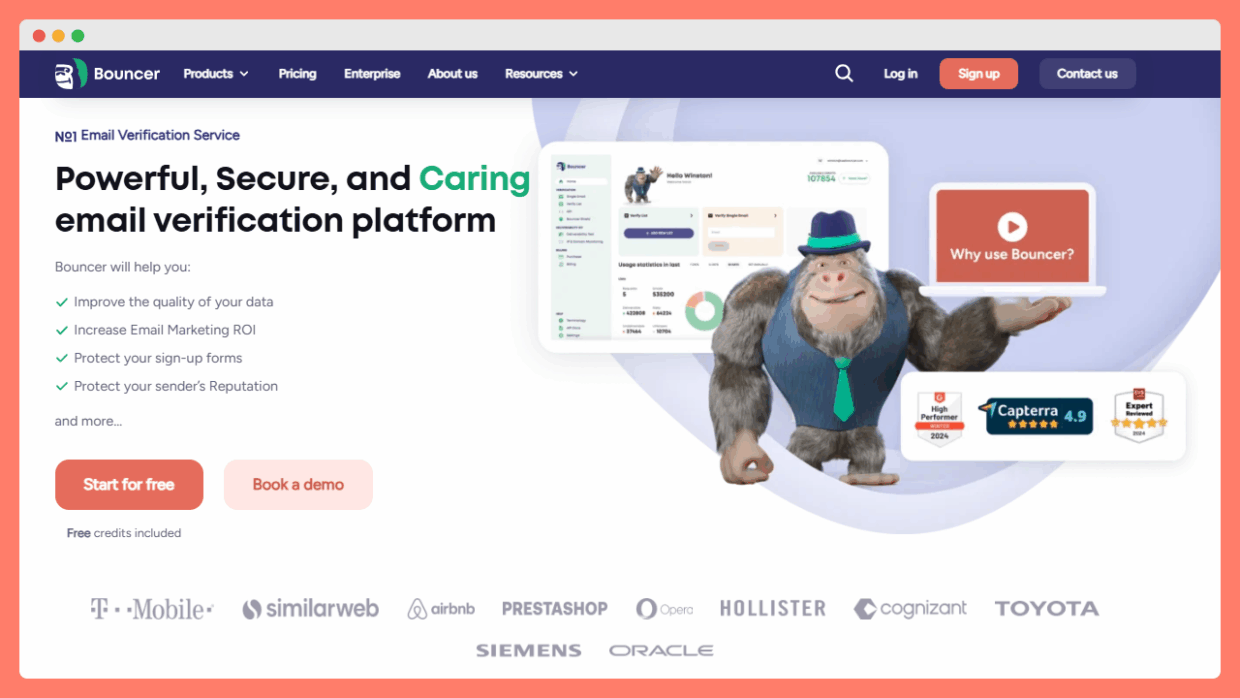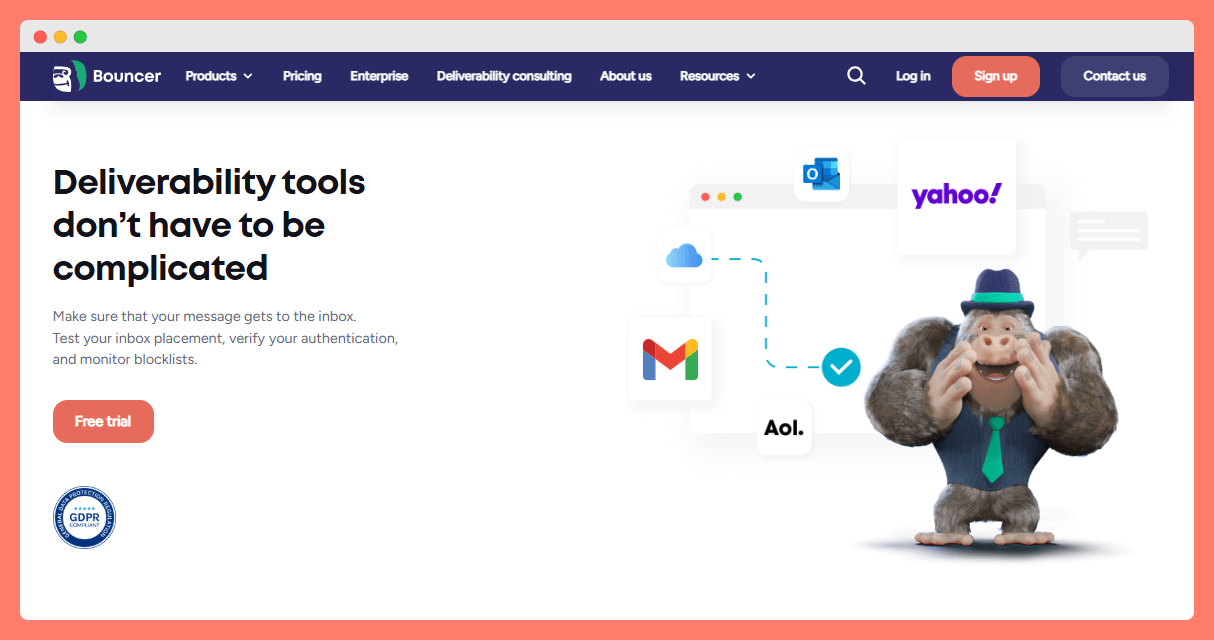But once you learn how these inboxes filter, score, and sort your messages, the picture changes. You can build trust, stay off blocklists, and actually start conversations.
That’s what this guide is about: understanding how B2B deliverability really works—and how tools like Bouncer help you pass every checkpoint.
Key differences between B2B & B2C deliverability
B2B and B2C emails might look similar on the surface, but behind the scenes, they live in two very different worlds.
✅ In consumer inboxes, you fight for attention.
✅ In business inboxes, you fight for permission.
The filters, timing, and expectations all change — and understanding those changes is where better deliverability begins.
First, corporate infrastructure and filters add layers most marketers don’t see until something breaks. You’re not dealing with just one mailbox provider. You’re dealing with:
- a patchwork of Microsoft 365 or Google Workspace,
- plus a security gateway in front,
- plus custom rules inside the company,
- plus many tools that often sit before the mailbox even look at your message.
One company may hard-block link shorteners. Another may dislike PDFs. So maybe there is the same sender and the same content, but there can be different outcomes.
Tolerance for error is lower in this context.
- 1. A handful of spam complaints at one domain can trigger a block that sticks.
- 2. A minor DMARC misalignment can stall a send.
- 3. A role account that no longer exists can tip your bounce pattern over a line.
With low volumes per domain, small incidents loom large. That’s why a steady ramp, tidy lists, and precise authentication matter so much here.
Engagement signals play out differently, too. Corporate users skim during work, not late at night on the couch. They prefer clear, work-related value over splashy polish. A clean subject that speaks to a job task beats clever wordplay. Replies often come after internal forwarding, so your “From” line and sender identity need to survive that hop.
Timing and frequency follow office rhythms. Sends during business hours tend to do better, with light early morning or early afternoon windows. Weekends rarely help, and holiday weeks can distort patterns. Plus, volume spikes during quarter-end can look risky to filters that track consistency.

What the numbers reveal about B2B deliverability?
In email deliverability, numbers tell that story best. Let’s unpack what’s really happening out there in the B2B world.
According to Mailmodo, B2B emails now average a 98.16% delivery rate. That’s high — but it hides sharp contrasts between tools, regions, and industries.
When it comes to email service providers, Google continues to lead the pack, with 87.2% inbox placement, while Microsoft Outlook sits lower at 75.6%. Outlook’s filters are stricter, often using “Sweep” or auto-sorting to move bulk messages out of sight. That single platform gap can erase part of your reach if your contact list leans corporate.
Regional differences for deliverability stand out, too.
The United States averages 85% inbox placement, while Europe reaches 89.1%. GDPR rules (once seen as a barrier) have cleaned up lists and improved sender reputations. Fewer spam traps, fewer generic contacts, more verified data.
Industries behave unevenly as well. Mining and manufacturing lead with 98% deliverability, but software and IT average only 80.9%. Why the drop? High cold outreach volume and new domains enter the ecosystem. The more new senders appear, the more cautious filters become.
Let’s go further with the average bounce rates, which hover around 2.33%, and keeping them below 2% signals good list hygiene. Spam complaint rates ideally stay under 0.3% — anything above that starts to damage domain trust.
Roughly 57.3% of B2B emailers now have proper SPF, DKIM, and DMARC alignment. That number’s growing, but it means almost half of senders still risk rejection from modern gateways like Proofpoint and Mimecast.
Meanwhile, automation is quietly changing the game. Around 63% of B2B marketers use AI tools for writing and optimization, and those personalized, AI-driven messages show 13.44% higher click-through rates. Yet, AI can’t fix weak data — that’s why 60% of senders still rely on regular list cleaning to maintain good standing.
How to turn these insights into action
When you line up all this data, one truth stands out — deliverability is fragile but fixable.
The brands with high inbox placement do four things consistently:
- They maintain alignment (SPF, DKIM, DMARC).
- They verify and refresh lists every few weeks.
- They keep their sending pace steady.
- They write like humans, not marketers.
Each habit protects reputation. If one company blocks you, it doesn’t mean all will. But the more incidents you stack, the harder it gets to climb back.
That’s why tools like Bouncer fit naturally into this process. They’re about keeping your base layer clean. Verification means fewer bounces, and fewer bounces mean filters treat you as reliable.

Common pitfalls in B2B deliverability
Yes, there are quite a few serious ones:
- Mass campaigns that ignore corporate policies cause quiet failures.
- Big attachments trigger scans or blocks.
- Link shorteners raise flags.
- Tracking domains with thin trust history can stall a message at the gateway.
And even when your message passes, delivery can slow enough to miss a window where the recipient was ready to act.
Unverified or stale corporate addresses are another trap. People change roles, shift teams, or leave. Domains get retired after mergers. Role accounts get locked. A list that felt fresh six months ago can pick up hard bounces and recycled traps now.
Moreover, inconsistency in sender identity hurts recognition. Some clients show only the display name at first glance. If yesterday’s message came from “Acme Research” and today’s says “Jordan at Acme,” a busy recipient may hit spam.
Overusing graphics or consumer-style language also drags you down. Heavy image blocks, vague promises, subject lines that mimic forwards or replies — these patterns read like tricks to both humans and machines.
Lastly, neglected infrastructure. SPF, DKIM, and DMARC must align. TLS should be active. Your bounce handling has to be tight. If you treat these as “set once” items, drift creeps in as subdomains, routing paths, or vendors change.
Strategies to improve B2B deliverability
You’ve seen where things can go wrong. Now let’s flip the script.
With the right setup and habits, you can turn those strict corporate filters into allies. Let’s go through the fixes that make the biggest difference.
Strengthen your email authentication
Start with strong authentication and keep it aligned. SPF and DKIM are table stakes, and DMARC tells receivers how to treat failures. Alignment at the domain level matters when gateways judge trust. If you use multiple tools to send, confirm they’re each covered. Review DMARC reports to spot random streams or typos that leak into live sends.
Keep your database clean and verified
Clean and verify your database on a schedule that matches your campaign pace. Corporate addresses decay faster than personal mail. Quarterly churn is common. Verify before large pushes and before you warm up, not after problems show up. Remove hard bounces the first time they appear. Sunset quiet contacts with a short win-back path, then stop.
Tip: Bouncer email verification can help here. It works in real time, with amazing accuracy and great speed.

Segment for real relevance
Segment for relevance that a time-pressed reader can feel. Role, industry, company size, and seniority change what “useful” means. A CFO wants risk and ROI. A product lead wants speed and fit. A security lead wants proof of safety and clean compliance lines. Tune the promise, proof, and next step for each. This reduces complaints and lifts quiet signals that feeds reputation over time.
Stay consistent with sender identity
Keep “From” names and domains consistent. Recognition lowers friction at open. If you need to send from a different domain or brand line, plan a transition. Tell people. Use the same signature block. Mirror the footer. Don’t spring a new identity in the middle of a sequence and expect filters or humans to connect the dots. Consistency is really comforting in corporate inboxes.
Mind your timing and sending rhythm
Tune timing and send patterns to business hours and avoid jagged volume. Steady beats spiky. Warm new IPs with measured ramps, but also warm new domains with the same care. A new domain blasting day one looks like a mistake to machines set to guard networks. Use smaller batches, spaced sends, and early signals from a sample to gauge reception before you scale.
Personalize like a professional
Personalize with context. Subject lines that reference a role or a current project land better than generic pushes. Inside the email, anchor the message to a known pain or a timely change in the recipient’s world. Skip “Re:” games. Keep the copy lean and grounded. A single next step helps. Think “short, useful note,” not “campaign asset.” That tone aligns with work inbox habits.
Watch your numbers
Monitor what matters and read errors like a daily paper, because they can tell you more than a blended “delivered” number. For example, keep an eye on complaint rates and track domain-level behavior across your top corporate targets. The earlier you catch a pattern, the easier it is to course-correct before reputation dips.
Putting it together: a practical flow that fits B2B reality
So what does good deliverability actually look like in this maze?
Of course, it starts with preparation. You check SPF, DKIM, and DMARC alignment first. Then you scan your list with a verifier to catch those hidden traps: the old addresses, the job-switchers, the domains that don’t exist anymore.
Once your foundation’s clean, you warm up. You send small, steady batches from a familiar “From” name, during work hours, when your contacts are at their desks. You monitor bounce codes and engagement by domain. When something odd pops up (like deferrals from one company), you slow down and adjust rather than blasting harder.
Then comes the human side. You speak directly to your reader’s role, with a personal yet professional tone. You keep images light and words real. No fake tricks, no heavy HTML. Your message looks like a note that belongs in their inbox. In this way, week by week, your results shift, replies can rise, and blocks drop.
Trade-offs and what to watch out for
Deliverability isn’t a single checklist you can tick forever. It’s closer to keep adjusting. And yes, there are trade-offs.
Segmentation and personalization
It’s tempting to micro-target every message, but too many micro-lists create more moving parts — that means more merge fields, more room for errors. A single broken variable can produce a message that looks robotic, undoing all that effort.
Action: Keep segments meaningful but manageable. You don’t need 50; you need 5 that really reflect your audience’s differences.
Tone
Over-caution can sound sterile. Corporate readers appreciate clarity, but not robotic stiffness. There’s room for light, conversational language — something that feels human and easy to scan.
Action: Think more “colleague dropping useful info” than “compliance memo.” The balance matters: safe formatting, yes; dull writing, no.
Infrastructure upkeep
Running multiple domains, IPs, and records adds real cost. Tools, audits, and occasional expert reviews take time. But skipping that investment costs more when filters start rejecting messages.
Action: Keep a small maintenance routine — quarterly checks, authentication refreshes, and bounce log reviews. Once it’s rhythm, it’s easy.
External factors
Corporate filters update silently. One month your messages fly; the next, a firewall patch changes behavior. You can’t control every setting, but you can spot patterns early.
Action: Domain-level monitoring, error tracking, and consistent sending windows give you visibility before issues spread.
Get your deliverability higher with Bouncer
Okay, but keeping lists perfect in B2B is a full-time job. People leave companies, domains expire, and typoed addresses sneak in even from forms you trust. Each bad contact adds a tiny dent to your reputation, and those dents add up.
That’s where Bouncer earns its keep.

Bouncer doesn’t change how you write emails; it strengthens what happens before you send them. It checks every address in your database, flags invalid or risky ones, and helps you avoid bounces that corporate filters track closely. It’s the quiet step between “send” and “success.”
Many senders pair it with their CRM or cold outreach tools to keep data verified in real time. When your list stays fresh, your bounce rate drops under 1–2%, and filters start recognizing your domain as trustworthy. That’s how reputation grows — not through luck, but consistency.
Bouncer is just a clean, practical layer that supports everything else you do for deliverability: authentication, segmentation, and engagement. The result? You spend less time chasing issues and more time writing emails people actually see.
Conclusion
B2B deliverability can be complex, sure, but it doesn’t have to be. Once you learn their logic, and once your data stays verified, you stop fighting the system and start working with it.
Every bounce you prevent, every record you align, every clear subject you write — they all count toward that invisible score that decides if your message lands or not. And with a tool like Bouncer quietly checking your lists behind the scenes, you’re simply giving yourself better odds every time you press send.
Try Bouncer today and make B2B deliverability your secret weapon.


